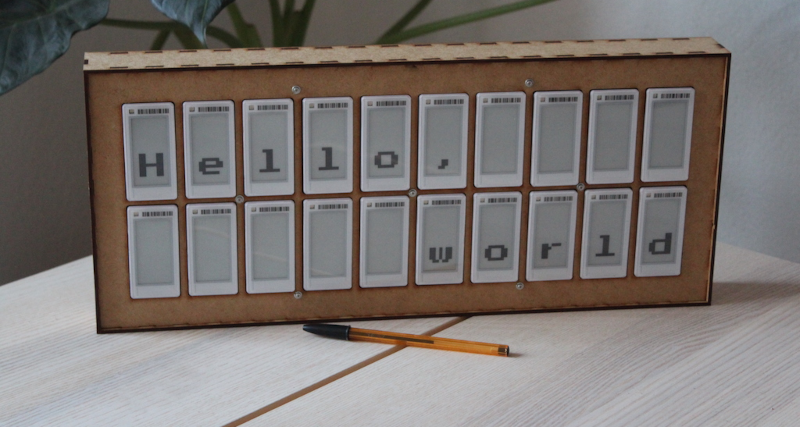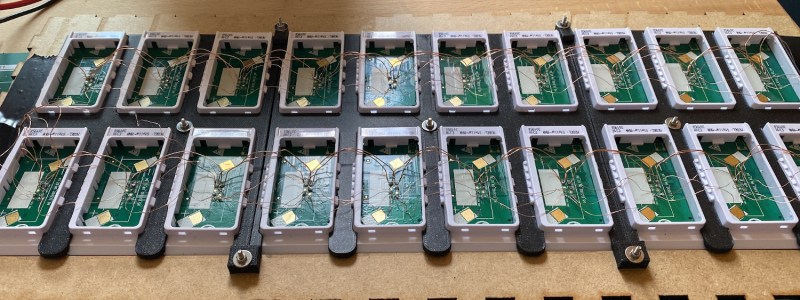How expensive is it to make a panel that uses e-ink technology? That might depend on how flexible you are. [RBarron] read about reverse engineering point-of-sale shelf labels and found them on eBay for just over a buck apiece. Next thing you know, 20 of them were working together in a single panel.
The panels use RF or NFC programming, normally, but have the capability to use BLE. Naturally you could just address each one in turn, but that isn’t very efficient. The approach here is to use one label as a BLE controller and it then drives the other displays in a serial daisy chain, where each label’s receive pin is set to the previous label’s transmit pin.
That allows a simple piece of code to read incoming messages and process the ones addressed to that label. Anything else just gets sent out the serial port. Only the BLE node has special firmware. At first, we thought each label would need an address and we wondered how it would be set other than having unique firmware for each one since there doesn’t appear to be a handy way to do a hardware-based configuration.
The actual solution is clever. Each message has a hop counter that each node decrements before passing the message along the chain. When the hop count is zero, the message is at its destination. Simple and very easy to configure. In theory, you could replace any of the labels after the first one with any other label and the system would still work correctly.
Even the wiring is clever, with a jig to bend the wire to ensure even spacing of each element on the panel. A laser-cut box finishes the project off nicely. The code is all available on GitHub. We’ve seen these kinds of tags used for things like weather stations. Not to mention conference badges.

















The video on the Github page of the display being written to is very satisfying, just in the way that the refresh of the individual screens is staggered so the whole thing moves in a wave.
I’ve never seen these shelf labels in the UK. At a glance online there are a couple of articles suggesting that they’re getting trialled more widely at the moment, so maybe they’ll turn up second hand in a few years.
Many shops seem to use them. Sometimes you’d be hard pressed to notice that the labels are actually e-ink, especially when they intentionally make the regular paper tags with a bezel to look like digital tags.
Yep most co-ops I’ve been into have them. Honestly I didn’t realize what they were till I saw one sitting face down on a shelf, surprisingly discreet
I can only think of one retailer in the US, Kohls, that uses them. From what I’ve noticed, they have a variety of sizes from smaller shelf tags up to e-reader size.
I’ve seen them at kohls (in the shoe department, the rest of the store has larger mono lcd price displays I guess due to cost) and either home depot or lowes (cant remember which, but they were the larger 3 color ones which was neat).
Best Buy and Whole Foods have been using them for years in the US.
Home depot uses larger ones that have black and yellow. Black and red is an option.
where DO people find these display by the lots?!?? in UK these are barely available (except the waveshare ones) and when they do become available each goes for 20 or more units of money…
Agree!
Yeah, I just looked on ebay and they’re like 23 USD for a single 2.9″ display.
I got a broken unit from a local supermarket. Unbelievably, it uses two large coin cells! That’s gotta be one of the worst design decisions I’ve ever seen…
Given supermarket lighting, and frequency of update, you’d have thought a supercap plus calculator-sized solar panel would keep these going forever. Then again, perhaps it was a deliberate decision to use coin cells, and justify a regular ‘service plan’?
Updating the display uses so much current that a supecap that fits inside the tag would not be enough.
Then again, standby uses so little current that the coin cells last for years and they’re cheap enough for that.
Supercaps come in at roughly 5 to 8 Wh/l whereas a lithium thionyl button cell can go up to 1200 Wh/l so if the supercapacitor can update once the lithium cell will work 150 times.
Then there’s also the self-discharge issue which goes up with capacitance, so a tiny calculator solar panel in an indirectly lit shelf may not be enough to keep a charge.
http://robotroom.com/Capacitor-Self-Discharge-2.html
“standby uses so little current”
Heh. I’ve got a bare Adafruit 2.13″ eink sitting on my desk for the last 6 months, that’s had a static picture with no visible degradation.
They didn’t mean the display. They meant the cap.
My preference would be wireless power supplied by the “tag setter”! IMO, if you’re gonna have batteries, then make the Rx good enough so an entire store can be written from a central computer…
AFAIK the RX *is* good enough that the transmitter doesn’t have to be particularly close. The NFC is for pairing & for manual actions.
Of course it is written from a central computer. There are transmitters in the roof throughout the store, either using IR or BLE. Whenever prices are changed in the system an updated is sent out to change all tags that need new prices.
After you have installed a tag you don’t need to touch it for 5-10 years until it’s time to change batteries, which is easily done in two minutes.
I’ve never seen these E-Ink shelf labels before; but if I do see one I’ll snag it and attach a price tag “borrowed” from something affordable like a loaf of bread. Uh…no – these days a loaf of bread is no longer affordable, much-less available to begin with.
Am I missing something or is there no ground between modules?
I see 4 wires between each ESL in some of the photographs.
Where to get these in the US For a buck? I see AliExpress has them for $1.78, none on ebay as TFA suggests.
Those ones for a dollar on AliExpress, those aren’t the panels themselves those are the little plastic clips they go into.
Yeah, I’m looking right now and the 2.13″ modules are still about $13 (although I see one on sale for $9.80).
That is an excellent design with the CR2450 coin cells. With the prices updated once per week the batteries last about 10 years, which is exactly the same as the batteries shelf life.
I’m a pre-sales engineer for Displaydata, one of the top ESL mfr’s in the world. Some of the comments are indeed true and some false, it makes for interesting reading. ESL’s are coming to a store near you, I’m making sure of it. Home Depot currently uses our Chroma74 yellow displays in their appliance section. Lowes does the same with a competitor. Kohls years ago had the really old 2nd generation LCD technology which has been superseded by the E-ink variants that everyone now uses. Kohls just recently changed vendors so their ESL install stopped looking like your old LCD watch from the 80’s.